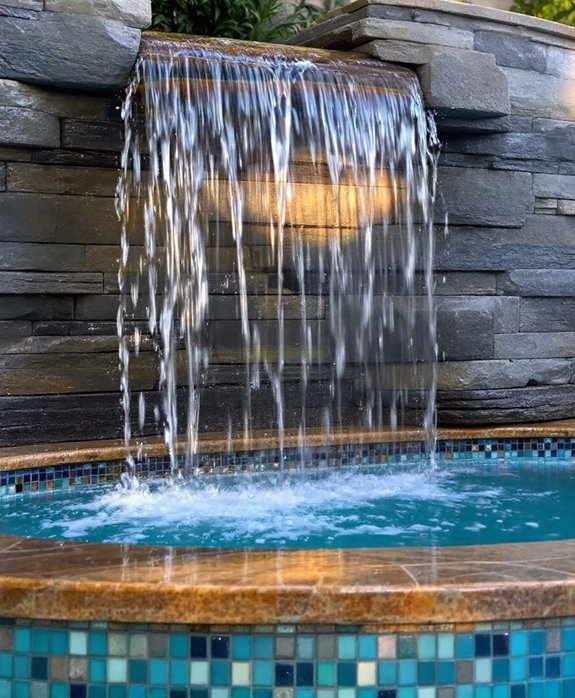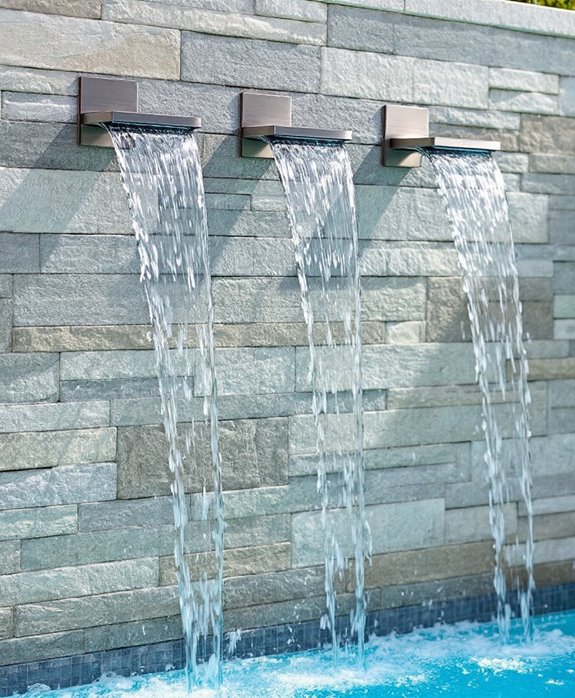To incorporate a waterfall into your pool design, start by choosing a style that suits your vision, like a sheer descent or rock waterfall. Plan its placement for both aesthetics and functionality, ensuring it’s visible from key areas. Use durable materials such as granite and incorporate proper plumbing with a powerful pump for ideal flow. Don’t forget about regular maintenance to keep everything running smoothly. Discover more insights on creating your perfect aquatic escape.
Key Takeaways
- Choose a waterfall style that complements your pool’s aesthetics, such as sheer descent or rock waterfalls for desired ambiance.
- Plan the waterfall’s placement for optimal visibility and ensure it aligns with existing pool equipment and dimensions.
- Select durable, weather-resistant materials like granite or limestone and integrate lightweight stones for vinyl liner pools.
- Install dedicated plumbing and circulation systems to enhance water flow and prevent clogs; avoid connecting to main pool plumbing.
- Regularly maintain the waterfall by cleaning pumps, inspecting for leaks, and monitoring water chemistry to prevent algae growth.
Choosing the Right Waterfall Style

How do you envision your pool area transforming with the right waterfall style? Selecting a waterfall design is essential for your pool design’s overall aesthetic. A sheer descent waterfall adds a modern vibe, while a rock waterfall delivers a rustic, natural look. If your space allows, tiered waterfalls can create dynamic movement and enchanting sounds, enhancing larger pools wonderfully. For stunning views, consider an infinity edge waterfall that visually merges water with the horizon. Custom sculpted waterfalls offer a unique opportunity to reflect your personal vision, making them a key focal point. Whichever style you choose, the waterfall serves as an artistic feature, enhancing the visual appeal and overall ambiance of your outdoor oasis.
Planning the Placement and Dimensions
When planning the placement and dimensions of your waterfall, it’s essential to integrate it seamlessly into your pool’s design. Aim for a total width of about 5 feet, ensuring aesthetic alignment with other elements. The waterfall should feature a center width of 24 inches, side lengths of 18 inches, with height variations of 12 inches on the sides and 18 inches at the center. Assess sunlight exposure to manage shade and prevent algae growth, while enhancing water quality. Place the waterfall where it’s visible from key viewing areas, maximizing functionality and appeal. Additionally, position it close to existing equipment for easy access to plumbing systems, vital for efficient water circulation and ideal feature operation.
Selecting Materials for Durability and Aesthetics

After determining the ideal placement and dimensions for your waterfall, the next step is selecting materials that guarantee both durability and aesthetics. Choose weather-resistant stones like granite, sandstone, or limestone for exceptional durability against the elements. When designing for vinyl liner pools, lightweight veneer stone is essential to avoid placing excessive weight on your pool walls, maintaining structural integrity. Incorporate ledger stone to wrap the base of the waterfall; it enhances aesthetics and smoothly blends with natural landscapes. Ascertain you utilize waterproofing materials, such as cement-based coatings or rubber pond liners, to preserve the waterfall structure and prevent erosion. This careful selection seamlessly integrates into the overall design, boosting visual appeal and reducing maintenance requirements for your stunning oasis.
Installing Plumbing and Water Circulation Systems
To guarantee your waterfall operates smoothly and enhances your pool’s aesthetics, installing dedicated plumbing and water circulation systems is essential. Avoid tying your waterfall feature into the main pool plumbing; instead, create dedicated loops for ideal water flow. Choose a powerful waterfall pump with high flow rates—ideally over 1,000 gallons per hour—to achieve that stunning sheer descent effect. Use two suction ports, spaced 24 inches apart, to facilitate effective water draw while meeting safety code requirements. Incorporate flow control valves to manage water distribution and minimize cavitation risks. When planning nighttime circulation, direct the pump towards pool jets while turning off the waterfall feature. This approach conserves energy and maintains water clarity, ensuring your design is both beautiful and efficient.
Maintenance Tips for Long-lasting Functionality

Maintaining your waterfall feature guarantees it remains a stunning centerpiece in your pool design. Prioritize regular cleaning of the pump strainer basket to prevent clogs, guaranteeing ideal water flows. A thorough inspection of waterproofing and plumbing systems will help you identify leaks or wear, allowing for timely repairs. Don’t forget to monitor water chemistry; maintaining the right pH and chlorine levels prevents algae growth, keeping the waterfall area clear and visually striking. Schedule seasonal maintenance, such as winterizing, to protect against cold-weather damage. Installing sediment traps also aids in catching debris before it reaches the waterfall, minimizing maintenance needs. Consulting with your pool builder about these necessary tools will guarantee your waterfall can enhance your pool for years to come.
Frequently Asked Questions
Can You Add a Waterfall Feature to an Existing Pool?
Yes, you can add a waterfall feature to your existing pool. Consider waterfall styles, design considerations, and the installation process. Explore maintenance tips, lighting options, and sound effects for landscape integration, water flow, and material choices.
How Much Does It Cost to Add a Waterfall to an Existing Pool?
Envision a serene oasis, but adding a waterfall often means budgeting $1,000-$10,000 for installation costs. Factor in maintenance, the right materials, and local contractor rates to guarantee your water feature thrives beautifully!
Are Pool Waterfalls Worth It?
Absolutely, pool waterfalls are worth it! They enhance pool aesthetics, provide soothing sound benefits, improve relaxation effects, and offer versatile design options. Just consider installation challenges and budget considerations for ideal water flow and landscaping integration.
Does a Waterfall Cool a Pool?
You might think a waterfall’s just for looks, but it actually cools your pool! With enhanced evaporation rates and improved water circulation, you’ll enjoy not just temperature regulation but a relaxing sound, energy efficiency, and stunning aesthetics.
Wrapping up
By thoughtfully integrating a waterfall into your pool design, you’re not just adding visual appeal but also creating a serene oasis. Envision the gentle sound of cascading water, shimmering like liquid diamonds under the sun, while lush greenery frames your retreat. With the right style, placement, and materials, your pool transforms into a lively ecosystem—a shimmering sanctuary that invites relaxation and rejuvenation. Welcome this harmonious blend of nature and design, and watch your outdoor space flourish.





